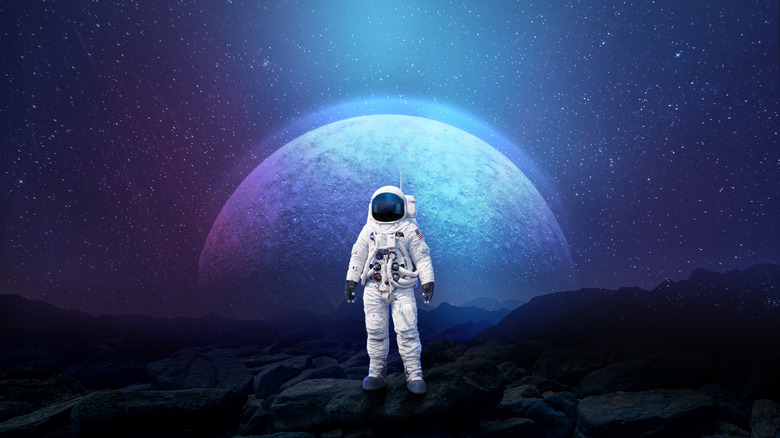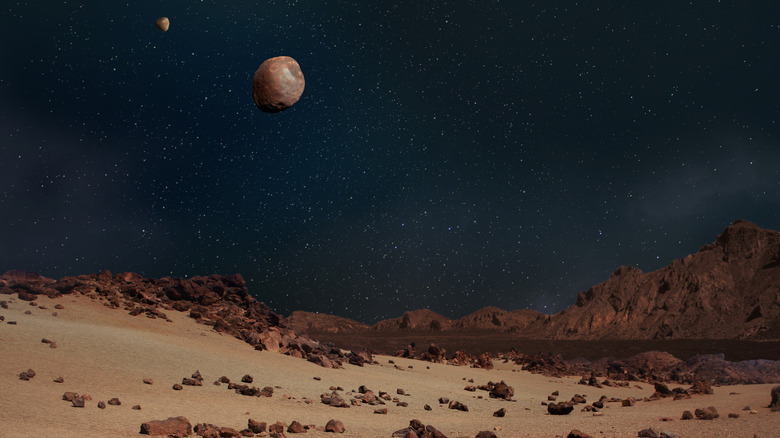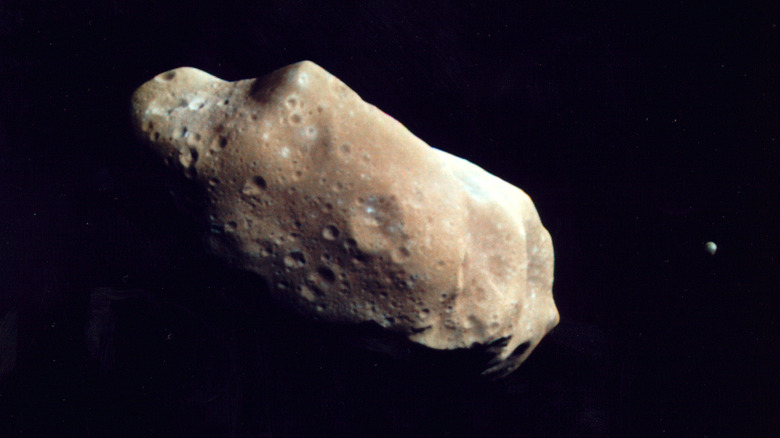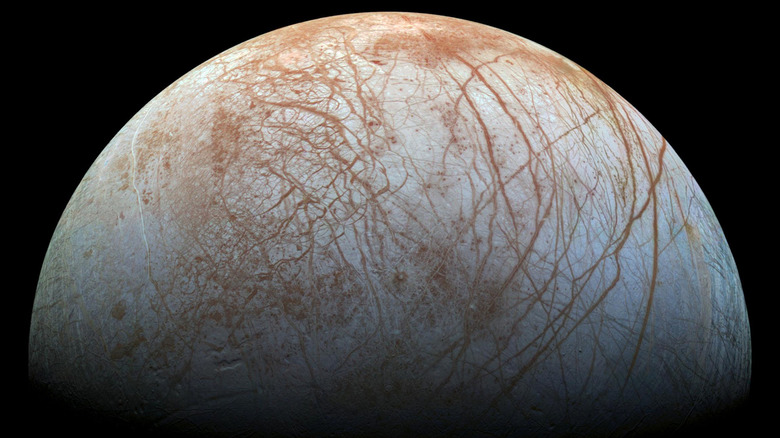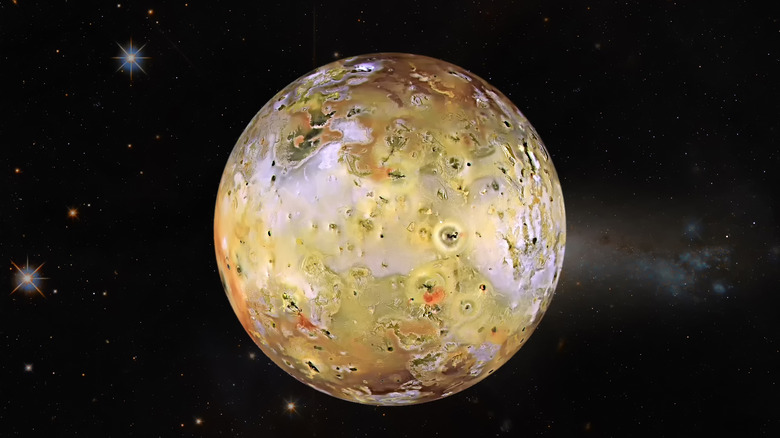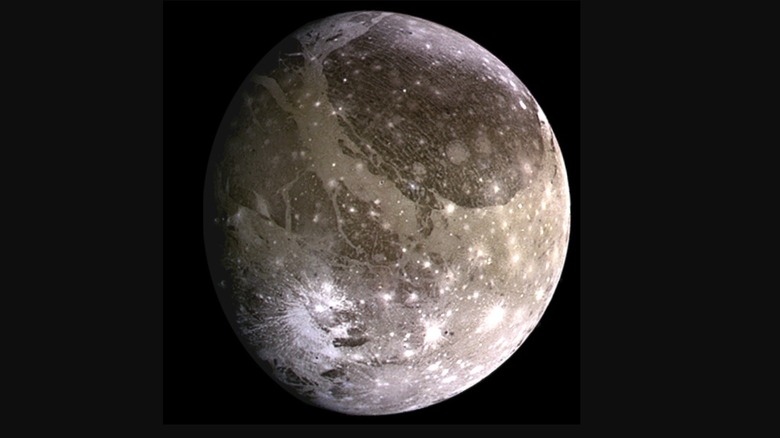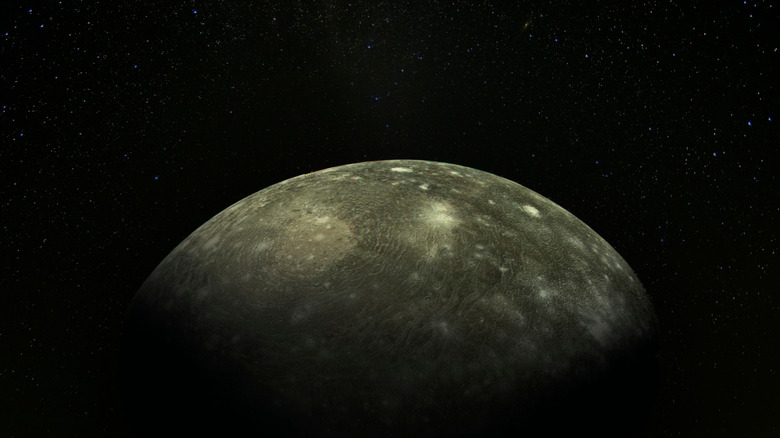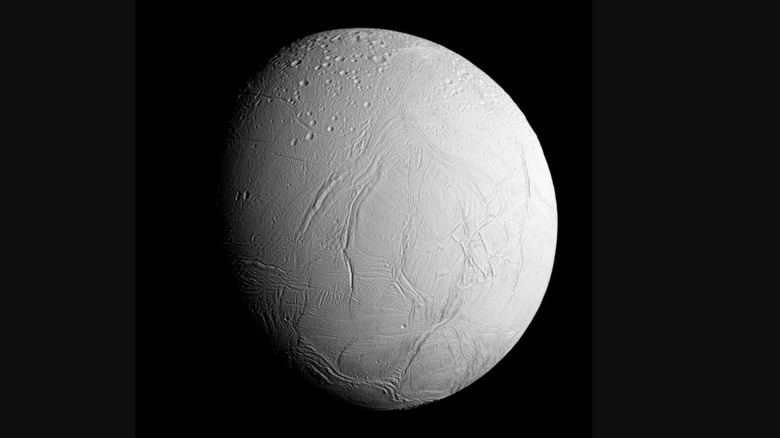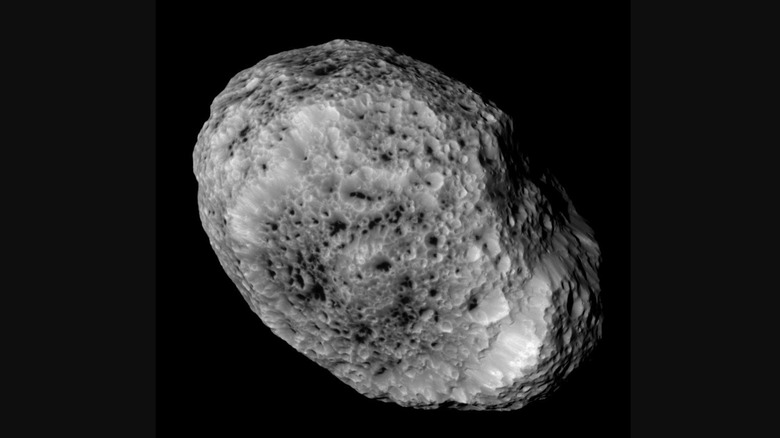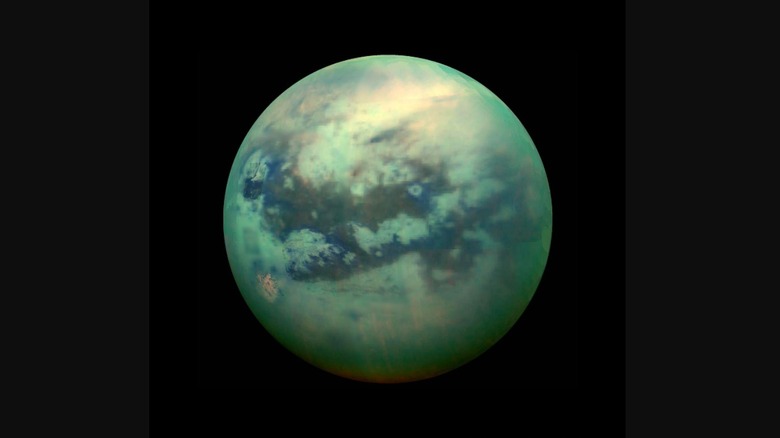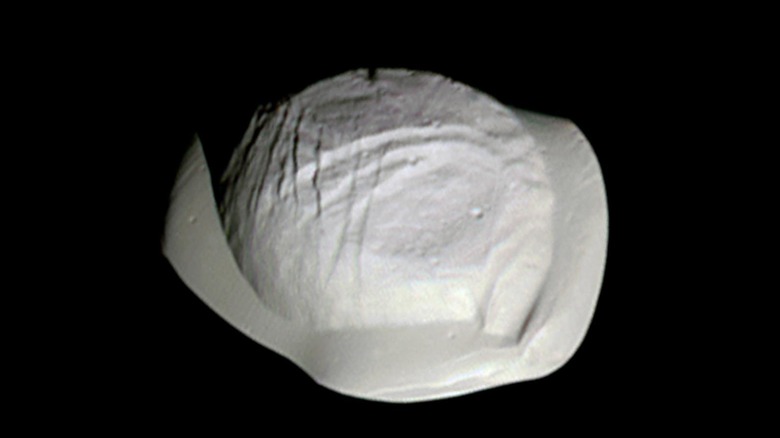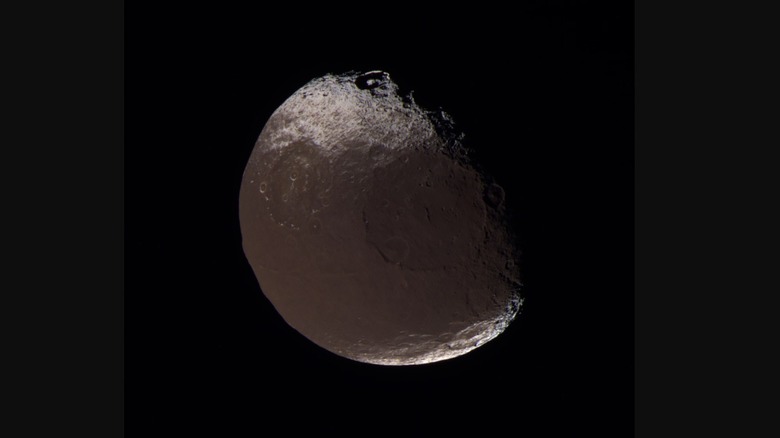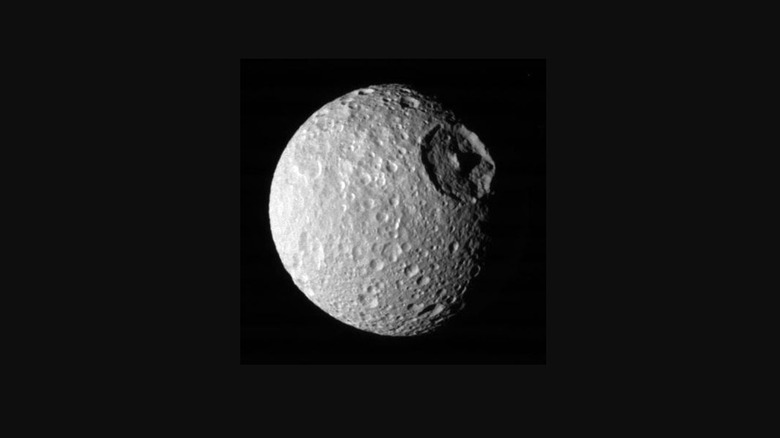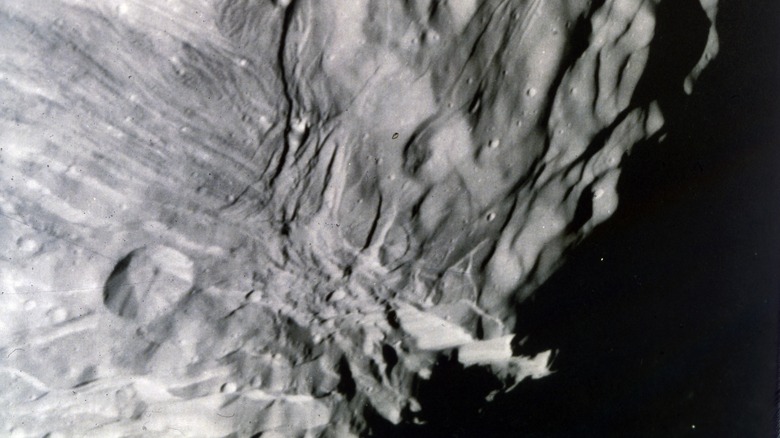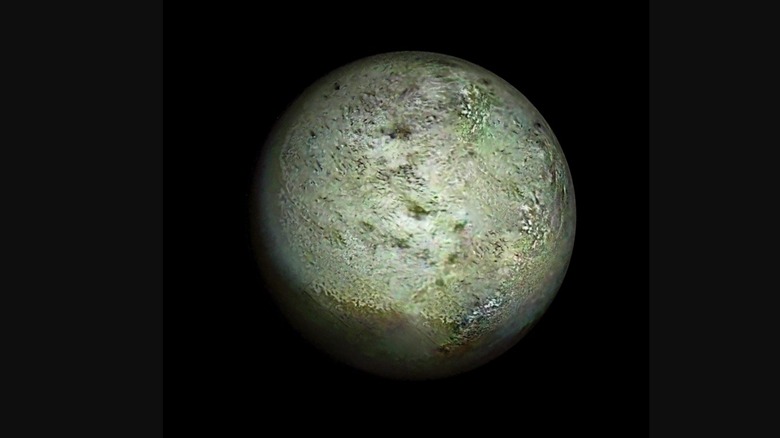Strange Moons Of The Solar System
A moon is a natural satellite that orbits a larger space object such as a planet or an asteroid. According to NASA, our solar system is home to over 200 moons, also referred to as satellites. This list seems to grow every year as missions into space reveal new and exotic moons. Most moons in our solar system swarm around the gas giants. Jupiter has 79 satellites just by itself, and Saturn is the current champ holding 82 satellites in its orbit.
Moons are also incredibly diverse. Some satellites, such as Earth's Moon, are large and act as a stabilizing force. Others are quite small, being only dozens of miles in diameter. Some have atmospheres while others feature icy oceans, and a few even broil in hellish volcanic activity. Some of these are so interesting that a future space traveler might forgo visiting the planet itself just to check out the far more interesting moons. Here are just a handful of the strangest moons in the solar system known to science.
Phobos
Of the inner planets, only Earth and Mars have moons. Mars has two: Deimos, which is smaller and more distant, and Phobos, which is larger and closer. Now, when we say larger, this needs to be put in perspective. Britannica states that Phobos is only 16.5 miles at its widest. So it really isn't that big, but it orbits the red planet at just 5,827 miles out and speeds along to circle it in under 8 hours. What is most alarming (if you are a Martian) is that Phobos is drawing ever closer to the planet. According to NASA, every year, the moon is pulled six feet closer to the planet. At that rate, in 50 million years, two scenarios may occur. First, it could crash right into the planet in a tremendous explosion. The second option, which is more aesthetically pleasing, is that the moon will break up into fragments forming a ring around the planet.
Dactyl
Dactyl has the distinction of being the only moon known to orbit an asteroid. NASA reports that Dactyl's potato-shaped asteroid is named Ida (pun was not intended by the discovers) and is part of the objects in the asteroid belt between Mars and Jupiter. When the Galileo spacecraft flew by on its mission to Jupiter in 1993, it did a close flyby and noticed Dactyl. The moon itself is tiny, 0.99 miles at its longest, but it is spherical, according to space.com. This round shape itself is puzzling since anything that small would not have enough gravity to pull itself into a spheroid. In addition, the age of Ida and Dactyl are a bit of a mystery. Craters on Ida suggest that it is ancient, but it is also part of the younger Koronis family of asteroids dated to only one or two billion years ago. It is clear, however, that although right now Dactyl is the only moon to orbit an asteroid, we will undoubtedly find others.
Europa
Europa is one of the oldest known and most intriguing moons. Britannica describes how this moon of Jupiter was first discovered in 1610 by Galileo Galilei and, with a 1,940-mile diameter, is only slightly smaller than our Moon. Europa, according to NASA, has a layer of ice on the surface, perhaps up to 15 miles thick, which floats upon an ocean that at some points could be 100 miles deep. This means that although this moon is but a fraction of the size of Earth, it may hold up to twice as much water. As a result, it has attracted much scientific attention.
Space.com reports that there have been a few flybys of Europa. Pioneers 10 and 11 as well as Voyagers 1 and 2 both passed in the 1970s. A longer study was performed by the Galileo mission from 1995 to 2003. Despite all the research, Europa still holds secrets. NASA reported that in 2012 the Hubble Space Telescope detected that the moon was ejecting water vapor into space, possibly caused by the tidal forces of Jupiter. Europa is slated to be studied further by NASA's Europa Clipper and the European Space Agency's (ESA) JUpiter ICy moons Explorer (JUICE). The thought is that with so much water, Europa may be a potential site of life.
Io
Any place in space is dangerous for future space travelers, but Jupiter's moon of Io should have flashing lights surrounding it shouting, "Do not under any circumstances land here." Io is Jupiter's fifth moon, according to space.com, and with a mean radius of 1,131.7 miles, it is a touch bigger than our Moon. It is also cold, with temperatures averaging about 202 degrees below zero. This is cold enough that sulfur dioxide freezes to form snowfields. But temperatures this low are not unusual for a moon this far from the Sun. The danger comes from Io being the most hellish place in the solar system. This moon features hundreds of volcanoes that launch lava miles up and plumes of sulfur hundreds of miles higher. Lava bubbles up, filling impact craters and covering the landscape so thoroughly that Io is constantly being resurfaced.
Io became the solar system's hell through gravity. NASA explains that it is tugged by Jupiter's gravity but also counter yanked by the large moons of Europa and Ganymede. These tidal forces cause the surface of Io to bulge up and down by 330 feet -– and this is a tide of rock, not like the watery tides on Earth that differ by only 60 feet.
Ganymede
Ganymede has the distinction of being the largest moon in the solar system. To put this in perspective, space.com tells us that this moon of Jupiter has a mean radius of 1,635 miles, making it a bit smaller than Mars but bigger than Mercury. Yet despite its size, Ganymede isn't very dense. Mercury, for example, weighs more than Ganymede. This might be because Ganymede is watery. NASA explains that the moon has a thick crust of ice, perhaps as much as 95 miles thick, under which lies a 60-mile deep saltwater ocean. The presence of liquid water naturally makes it a point of interest for those searching for extraterrestrial life.
Another interesting feature of Ganymede, as noted by NASA, is that its the only one of its kind to have an independent magnetic field — discovered in 1996 by NASA's Galileo spacecraft. This was only made clear upon close approach since the moon's own magnetic field is swallowed up by Jupiter's immense one. The interaction between the two magnetic fields causes intense auroras on Ganymede.
Callisto
Callisto, Jupiter's fourth moon, may well be the most banged-up looking moon in the solar system. As analyzed by Britannica, this 3,000-mile diameter satellite is about half as dense as our Moon, which indicates that it is half rock, half ice. Callisto shows an inordinate amount of pockmarks left from impact craters over the eons. What this usually indicates is that there is little geologic activity within the moon since if there were, such as active volcanoes and the like, the landscape would get remade. In essence, Callisto has long been discounted as dead a moon as can be in the solar system.
Or is it?
Recent evidence gathered by modern space exploration shows that there may be more to Callisto than meets the eye. Space.com reports that Callisto seems to have a fluctuating magnetic field that is caused by Jupiter's powerful magnetic field, creating an electrical current within the planet. This was supported by observations by NASA and the Hubble Space Telescope. It is suspected that this may be due to a salty ocean under the moon's crust which can conduct electricity.
Enceladus
Enceladus has the unique distinction of being not only the brightest moon of Saturn but also the brightest object in our solar system. According to Professor Courtney Seligman, this satellite's albedo, or reflectivity, is so great that it bounces back nearly 100% of the light from the sun. This has puzzled scientists for some time. NASA explains that the Voyager mission of the 1980s showed that the 310-mile diameter Enceladus was an ice world of smooth whiteness that bounced all the light off it. Its average temperature of 330 degrees below zero makes ice the equivalent of rocks.
We learned more about Enceladus during the Cassini mission, first in 2005 and then after a close flyby in 2008. This probe, which had been sent to study Saturn and its system, found that despite its cold temperatures, Enceladus had a 6-mile deep ocean of liquid saltwater beneath its up to 25-mile thick icy crust. What is more, Enceladus continually sends plumes of ice particles mixed with other chemicals continuously into space. It is suspected that tidal action, caused by Saturn's gravity, allows the liquid ocean to exist and also causes the eruption of ice particles. Because of all this activity, the surface of Enceladus is constantly refreshed with new ice, thus giving it a white sheen and high albedo.
Hyperion
Hyperion's claim to fame is that it looks like a spongy potato. This Saturnian moon is reported by space.com to be rather small. At its longest point, it is only 255 miles in diameter. What makes Hyperion unique is that it is the largest nonspherical moon in the solar system. Aside from not being round, it also appears to contain many porous structures, thus giving it the appearance of a sponge or a tufa rock. In addition, this moon does not rotate in a predictable way, and it speeds up or slows down in its elliptical orbit due to its relative position to the large moon Titan.
NASA argues that potatoes in space aren't born that way. Hyperion was likely a part of a larger moon that had been destroyed in a prior collision. The moon itself seems to also have a large amount of ice within its crater pores. The Cassini spacecraft discovered one other phenomenon associated with Hyperion. When it performed a close flyby in 2005, Hyperion sent a charge of static electricity at the probe. While Cassini was unharmed, scientists continue to study the data to understand future space hazards.
Titan
With its 3,200 mile diameter, Titan is titanic. NASA tells us that this is Saturn's largest moon and holds the title of the second-largest moon in the solar system. Titan is also the only moon known to have a thick atmosphere. This was first studied, as reported by the Smithsonian National Air and Space Museum during the flyby of the Voyager 1 mission, which photographed a hazy mass of methane and nitrogen. Voyager also made scientists notice that this satellite had many similarities to Earth. Titan has a large amount of carbon as well as evidence of organic chemical reactions such as were on our own planet some four billion years ago when life began.
Titan also has regular patterns of precipitation. However, since the temperature is a balmy 290 degrees below zero, liquid methane and ethene serve as the liquid that fills lakes and rivers. It also has physical features that would look vaguely familiar to us on Earth, such as dunes and a constantly changing surface due to tectonic activity, but in this case, water is the primary driver. Curiously, the equivalent of a lava flow on Titan would be liquid water. As a result, scientists have been eying Titan as a place that might harbor life in its subsurface water or even more unusual life in its liquid gas lakes and rivers.
Saturn's shepherd moons
Several of Saturn's moons, including Pan, Daphnis, and Atlas, are classified together as shepherd moons. However, instead of herding sheep, these satellites herd rings with a gravity crook. These moons are tiny. According to NASA, the potato-shaped Epimetheus has an average 36-mile radius and is the largest shepherd moon. The others are much tinier. Atlas has an average radius of just 9.4 miles, while Daphnis is only 2.4 miles. The function of these shepherds is to clear spaces between Saturn's famous rings or, in the case of Atlas, trim the edge of one. They do this at a fast pace. Pan, for example, orbits Saturn in 13.8 hours while Atlas does it in 14.4. Consider that our Moon orbits Earth in a little under a month. What makes them even stranger is their irregular appearance: Atlas is pointy while Pan looks like a 1950's conception of a UFO. According to the New York Times, the shepherd moons are made mostly of ice and accrete even more ice as they make their endless revolutions around the planet. Other planets in the solar system have such shepherds for their less spectacular ring systems, including Jupiter and Neptune.
Iapetus
Saturn's moon of Iapetus has been compared to the yin and yang symbol since one side is coal black and the other side bright. NASA explains that Iapetus is made of three parts ice and one part rock, but this does not explain why the two hemispheres look so different. There are several theories as to why. One is that the nearby moon of Phoebe ejects particles onto Iapetus, causing its dark side to get so dark. Another explanation is ice volcanism. A leading theory was offered in 2007 after the Cassini probe showed that a process called thermal segregation might be causing the yin and yang effect. Iapetus's day lasts for 79 Earth days. This is so long that the dark material can heat up from exposure to sunlight. Keep in mind that by heating up, the dark side only reaches 226 degrees below zero while the light side is 280 degrees below zero. On the dark side, ice sublimates and then relocates on the brighter side. This means that the dark side gets darker and the bright side brighter.
Another curious feature of Iapetus is reported by space.com to be a set of encircling mountains, dubbed the Voyager Mountains, around its equator. Some are 12 miles high. What, if any, role these mountains played in this moon's astounding coloration is unclear. However, if you were to visit and climb one of these mountains, you would be ensured one of the best views of Saturn and its rings from anywhere.
Mimas
Obi-Wan Kenobi may have said, "That's no moon, it's a space station," in reference to the Death Star in "Star Wars: Episode IV – A New Hope," but had he seen Saturn's moon Mimas afterward, he may have uttered, "That's no space station, it's a moon."
Mimas is small, with an average 123-mile radius according to NASA and at only 115,000 miles out from Saturn has been subject to intense bombardment from asteroids. Most of these asteroid craters are large, with many over 25 miles wide. Yet these are small compared to a huge impact crater, called the Herschel Crater, which is 80 miles wide. This crater is located in such a way that it makes the moon look at first blush like Emperor Palpatine built it.
There is also another puzzle about Mimas that perplexes scientists. Because of its close elliptical orbit and because it is mainly made of ice, there should theoretically be ice volcanic activity such as on Enceladus. In fact, it has a more elliptical orbit which means there should be more tidal action to cause massive water geysers. Strangely, however, this moon does not have it. It seems to be completely frozen solid –- and there is no solid explanation of why. Space.com reports that this has led to a so-called "Mimas Test," in which any explanation of Enceladus's icy geyser action has to also explain why Mimas does not have any.
Miranda
One of the more mysterious moons is Miranda, the smallest and innermost of Uranus's five moons. According to Britannica, the 290-mile diameter satellite was first discovered in 1948 but it wasn't really closely studied until 1986, when the Voyager 2 probe was able to do a close flyby and take photographs. These images puzzled scientists. As described by NASA, Miranda is the "Frankenstein's monster" of the solar system. Its terrain seems to be composed of a patchwork of different physical features. There are great fault canyons 12 times deeper than the Grand Canyon, scores of cratering, and sinuous valleys. Curiously, NASA points out that if you fell from one of Miranda's higher cliffs, it would take 10 minutes to reach the bottom -– although this is mainly because its gravity is much lower than Earth's.
Scientists have several theories about Miranda. One is that it was made from a cosmic moon mashup. Another is that it was impacted by multiple asteroids which disrupted the surface. A third is that strange tectonic activity within Miranda gave it its remarkable features. The mysteries of Miranda are likely to remain until another spacecraft can visit that corner of the solar system.
Triton
Our tour of the moons of the solar system ends with Triton, the largest of Neptune's moons, but its distinction is based not on size but on weird habits. According to NASA, this 1,680-mile diameter moon is unusual because it orbits in the opposite direction of Neptune's rotation, something called retrograde. Additionally, NOAA explains that Triton rotates at 157 degrees to the axis of Neptune's rotation. Practically speaking, what this means is that Triton's north and south poles alternately face the Sun. It is assumed that this causes wide disparities in any seasons on Triton. These strange characteristics are likely because Triton was originally a Kuiper belt object on the edge of the solar system that had been captured by Neptune's gravity. Scientists often compare Triton to Pluto, which is the large Kuiper belt object that had once been considered a planet.
Since Triton is so distant from the Sun, it is cold with an average of 391degrees below zero. Like other planets at such a distance, gasses freeze (particularly nitrogen on Triton), and volcanism, when it occurs, involves melted ice rather than melted rock. For example, one 5-mile high plume of water vapor was observed to have erupted from an ice volcano. Its icy covering reflects almost all light which contributes to its coldness.
